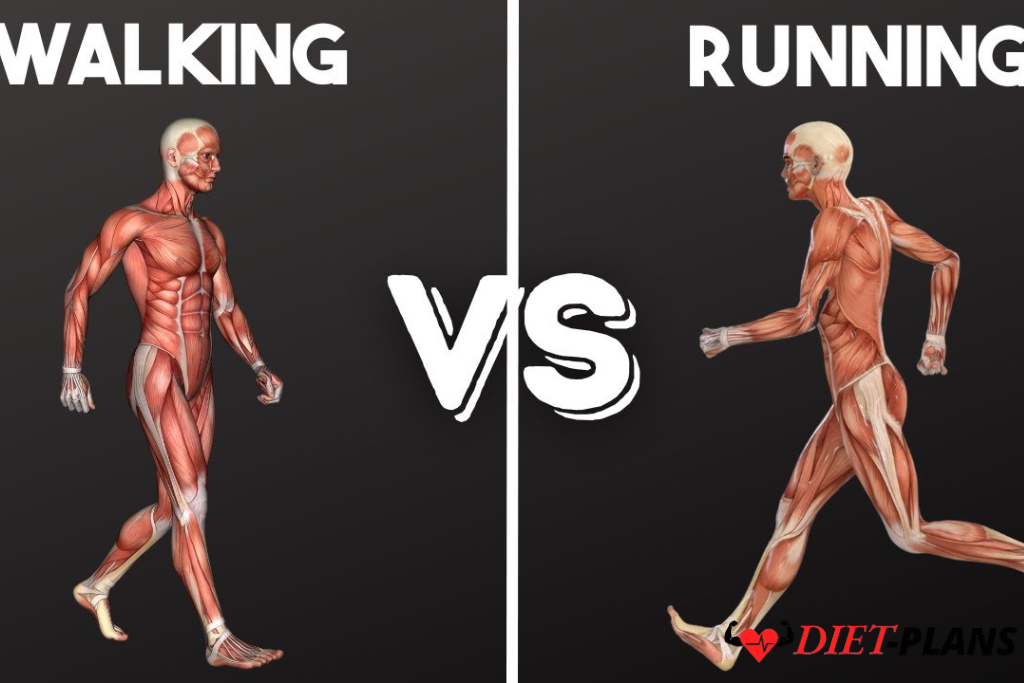Table of Contents
ToggleIs Running or Walking the Best Choice for Fat Loss?
Walking and running are both excellent forms of exercise to get in shape and are thought to be beneficial for cardiovascular health. The intensity of running is usually a favorite among runners, and walkers think it’s a healthy activity.
Walking vs. running, however, may be properly analyzed if we particularly discuss weight reduction. In addition to this, several other elements influence whether a person should run or walk to lose weight. First, let’s talk about some fundamentals!
Running vs. Walking: Important Distinctions

Running and walking are both excellent forms of cardiovascular exercise, as was previously indicated. There are benefits to walking as well as ones to running. Choosing between them is based on one’s fitness goals and ambitions; none is “better” than the other. Running daily has various benefits, particularly for weight loss. Conversely, walking offers health advantages, including weight maintenance and a lower risk of heart disease and stroke. Now let’s talk about some different viewpoints on walking versus running.
Is It Easier to Begin Running?
Walking is an activity that humans rely heavily on, so it’s a logical choice for novices. There are also many advantages to walking, no doubt about it. It can be done anywhere, requires no special equipment, and is less taxing on the joints. People frequently choose to walk on the treadmill since it is a simple and well-known activity that is beneficial for those who are new to fitness. Since running demands greater power and endurance and can result in injuries if done incorrectly, it can be a little daunting for novices. However, if you enjoy taking walks and are willing to push yourself, running can be the next step in your fat-loss quest.
Which is More Effective at Burning Calories?
Many of the advantages of running may also be obtained via walking. In addition, some research indicates that running burns almost twice as many calories as walking.
In terms of statistics, a person must expend around 3,500 calories to lose one pound. Running is seen as a better option than walking if your goal is to lose weight or fat.
Walking may still be an effective way for beginners to get in shape if they struggle with hard running. It can strengthen your heart and increase your vitality in general.
Convenience and Time
Time might be an important consideration for people with hectic schedules. You can fit a 30-minute run into your schedule if you’re trying to reduce weight but are short on time. Compared to walking, it helps you burn more calories. Running might indeed assist you in reaching your weight loss objectives.
Walking, on the other hand, takes more time to burn the same number of calories, but this time may be readily added to your day by dividing it up into shorter periods. These walks can be broken up into walking meetings, lunch breaks, or while doing housework.
Comparing Walking and Running to Lose Weight
Speed and Power Walking
Speed walking is a kind of walk that can be done at a brisk pace, usually 3 mph or more. One thing to note here is that an individual’s heart rate is significantly elevated during speed walking. An individual can burn more calories per minute by speed walking instead of walking at the usual pace.
Secondly, there is power walking, which is usually performed from 3 mph to 5 mph, but some power walkers reach speeds of 7 to 10 mph. Power walking also burns a somewhat equal number of calories as running. For instance, power walking at 4 mph can burn the same number of calories as jogging at 4 mph.
Incline Walking vs. Running
One of the most suggested ways of reducing fat is incline walking; it indeed has various benefits. It involves walking uphill, helping you cut off some of the extra fat from the thigh and hip area. Take note: the higher the incline, the more calories are burnt. Compared to walking on a flat surface, you burn more calories at an incline.
You can look for a hilly area or walk on an incline mode on the treadmill. For a better result, increase the incline by 5, 10, or 15% at a time to practice. If you’re a beginner at incline walking, you can start steadily and work up to a 15% incline.
Combining Walking and Running for Best Results
The debate about walking vs. running is ongoing, but we cannot forget the people who prefer to combine these practices; it is certainly a trendy method, mainly known as interval training. It is an activity where an individual can alternate between walking and running, as per their comfort. This technique can further boost an individual’s metabolism and keep the body guessing, helping lose fat. If you are a beginner, you can start with a combination of short running intervals and prolonged walking periods, and then later you can increase your running time as your fitness improves.

